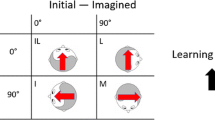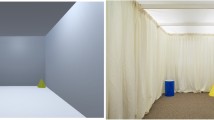Abstract
Human orientation and spatial cognition partlydepends on our ability to remember sets ofvisual landmarks and imagine their relationshipto us from a different viewpoint. We normallymake large body rotations only about a singleaxis which is aligned with gravity. However,astronauts who try to recognize environmentsrotated in 3 dimensions report that theirterrestrial ability to imagine the relativeorientation of remembered landmarks does noteasily generalize. The ability of humansubjects to learn to mentally rotate a simplearray of six objects around them was studied in1-G laboratory experiments. Subjects weretested in a cubic chamber (n = 73) and aequivalent virtual environment (n = 24),analogous to the interior of a space stationnode module. A picture of an object waspresented at the center of each wall. Subjectshad to memorize the spatial relationships amongthe six objects and learn to predict thedirection to a specific object if their bodywere in a specified 3D orientation. Percentcorrect learning curves and response times weremeasured. Most subjects achieved high accuracyfrom a given viewpoint within 20 trials,regardless of roll orientation, and learned asecond view direction with equal or greaterease. Performance of the subject group thatused a head mounted display/head tracker wasqualitatively similar to that of the secondgroup tested in a physical node simulator. Body position with respect to gravity had asignificant but minor effect on performance ofeach group, suggesting that results may alsoapply to weightless situations. A correlationwas found between task performance measures andconventional paper-and-pencil tests of fieldindependence and 2&3 dimensional figurerotation ability.
Similar content being viewed by others
References
Arthur, W. and Day, D. (1991). Examination of the construct validity of alternative measures of field dependence/independence. Perceptual and Motor Skills 72: 851–859.
Asch, S.E. and Witkin, H.A. (1948). Studies in space orientation II. Perception of the upright with displaced visual fields and with body tilted. Journal of Experimental Psychology 38: 455–477
Bryant, D.J. and Tversky, B. (1992). Internal and external spatial frameworks for representing described scenes. Journal of Memory and Language 31: 74–98
Ekstrom, R.B., French, J.W., Harman, H.H. and Derman, D. (1976). Manual for Kit of Factor-Referenced Cognitive Tests. Princeton, NJ: Educational Testing Service.
Franklin, N. and Tversky, B. (1990). Searching imagined environments. Journal of Experimental Psychology: General 119(5): 63–76.
Franklin, N., Tversky, B. and Coon, V. (1992). Switching points of view in spatial mental models. Memory and Cognition 20(5): 507–518.
Huttenlocher, J. and Presson, C.C. (1979). The coding and transformation of spatial information. Cognitive Psychology 11: 375–394.
Ivanenko, Y.P., Grasso, R., Israel, I. and Berthoz, A. (1997). The contribution of otoliths and semicircular canals to the perception of two-dimensional passive whole-body motion in humans. Journal of Physiology, London 502: 223–233.
Loomis, J.M., Klatzky, R.L., Golledge, R.G., Cicinelli, J.G., Pellegrino, J.W. and Fry, P. (1993). Nonvisual navigation by blind and sighted: Assessment of path integration ability. Journal of Experimental Psychology: General 122: 73–91.
Loomis, J.M., Da Silva, J.A., Fujita, N. and Fukusima, S.S. (1992). Visual space perception and visually directed action. Journal of Experimental Psychology: Human Perception and Performance 18: 906–922.
McDonald, T.P. and Pelligrino, J.W. (1993). Psychological perspectives on spatial cognition, Ch. 3. In T. Garling and R.G. Colledge (eds.), Behavior and Environment: Psychological and Geographical Approaches. Amsterdam: Elsevier.
Mittelstaedt, M.L. and Glasauer, S. (1991). Idiothetic navigation in gerbils and humans. Zoologische Jahrbucher Abteilungun fur algemeine Zoologie und Physiologie der Tiere 95: 427–435.
Oman C.M., Lichtenberg B.K., Money, K.E., McCoy, R.K. (1986). M.I.T./Canadian vestibular experiments on the Spacelab-1 mission: 4. Space motion sickness: symptoms, stimuli, and predictability. Experimental Brain Research 64: 316–334.
Parker, D.E. and Harm, D.L. et al. (1993). Self-attitude awareness training: an aid to effective performance in microgravity and virtual environments? Proceedings: Conference on Intelligent Computer-Aided Training and Virtual Environment Techology, NASA Johnson Space Center, Houston TX.
Pick, H.L. Jr. and Rieser, J.J. (1982). Childlren's cognitive mapping. In M. Potegal (ed.), Spatial Orientation: Development and Physiological Bases (pp. 107–128). New York: Academic Press.
Rieser, J.J. (1989). Access to knowledge of spatial structure at novel points of observation. Journal of Experimental Psychology: Learning, Memory and Cognition 15(6): 1157–1165.
Rieser, J.J., Guth, D.A. and Hill, E.W. (1986). Sensitivity to perspective structure while walking without vision. Perception 15: 173–188.
Witkin, H.A., Oltman, P., Raskin, E. and Karp, S. (1971). Manual for the Embedded Figures Tests. Palo Alto, CA: Consulting Psychologists Press.
Wraga, M., Creem, S.H. and Proffitt, D.R. (1999). The influence of spatial reference frames on imagined object-and view rotations. Acta Psychologica 102: 247–264.
Author information
Authors and Affiliations
Corresponding author
Rights and permissions
About this article
Cite this article
Oman, C.M., Shebilske, W.L., Richards, J.T. et al. Three dimensional spatial memory and learning in real and virtual environments. Spatial Cognition and Computation 2, 355–372 (2000). https://doi.org/10.1023/A:1015548105563
Issue Date:
DOI: https://doi.org/10.1023/A:1015548105563




